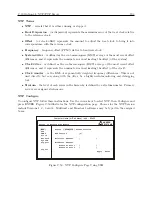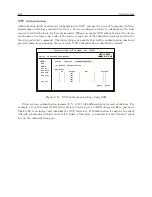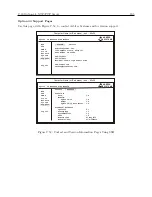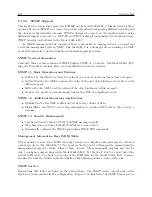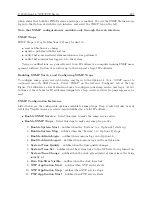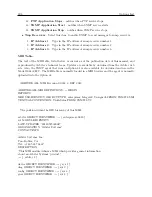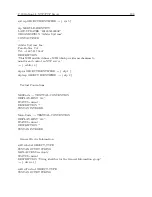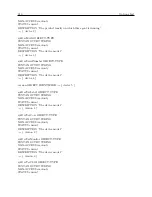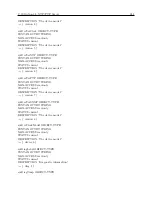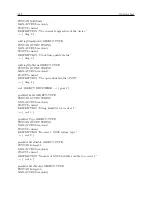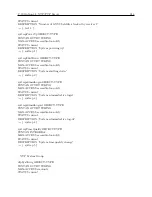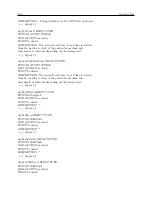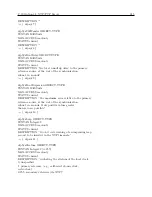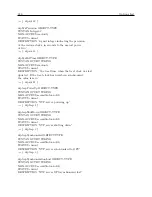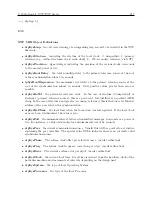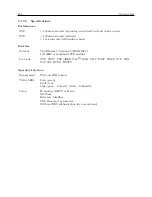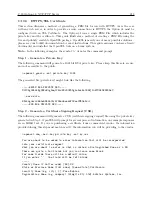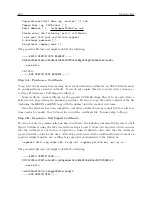
C.19 Option 34: NTP/PTP Server
217
::=
{
ntptrap 4
}
END
NTP MIB Object Definitions
•
ntpSysLeap
– two-bit code warning of an impending leap second to be inserted in the NTP
timescale.
•
ntpSysStratum
– indicating the stratum of the local clock.
0, unspecified; 1, primary
reference (e.g., calibrated atomic clock, radio clock); 2 – 255, secondary reference (via NTP).
•
ntpSysPrecision
– signed integer indicating the precision of the various clocks, in seconds
to the nearest power of two.
•
ntpSysRootDelay
– the total roundtrip delay to the primary reference source at the root
of the synchronization subnet, in seconds.
•
tpSysRootDispersion
– the maximum error relative to the primary reference source at the
root of the synchronization subnet, in seconds. Only positive values greater than zero are
possible.
•
ntpSysRefId
– the particular reference clock. In the case of stratum 0 (unspecified) or
stratum 1 (primary reference source), this is a pour-octet, left-justified, zero-padded ASCII
string. In the case of stratum 2 and greater (secondary reference) this is the four-octet Internet
address of the peer selected for synchronization.
•
ntpSysRefTime
– the local time when the local clock was last updated. If the local clock
as never been synchronized, the value is zero.
•
ntpSysPoll
– the minimum interval between transmitted messages, in seconds as a power of
two. For instance, a value of six indicates a minimum interval of 64 seconds.
•
ntpSysPeer
– the current synchronization source. Usually this will be a pointer to a structure
containing the peer variables. The special value NULL indicates there is no currently valid
synchronization source.
•
ntpSysPhase
– The system clock offset per selected source. (needs verification)
•
ntpSysFreq
– The system clock frequency correction per ntpd. (needs verification)
•
ntpSysError
– The current system error per ntpd? (needs verification)
•
ntpSysClock
– the current local time. Local time is derived from the hardware clock of the
particular machine and increments at intervals depending on the design used.
•
ntpSysSystem
– the type of local Operating System.
•
ntpSysProcessor
– the type of the local Processor.
Содержание 1084A
Страница 4: ...iv ...
Страница 6: ...vi ...
Страница 18: ...xviii LIST OF FIGURES ...
Страница 23: ...1 4 Attaching Rack Mount Ears to 1084A B C Series Clocks 3 Figure 1 2 Attaching Rack Mount Ears ...
Страница 24: ...4 Unpacking the Clock ...
Страница 36: ...16 Connecting Inlet Power Input and Output Signals ...
Страница 39: ...4 1 GPS Antenna Installation 19 Figure 4 2 Antenna Mounting Bracket Figure 4 3 Antenna Mounting with AS0044600 ...
Страница 44: ...24 GPS Antenna and Cable Information ...
Страница 114: ...94 Startup and Basic Operation ...
Страница 123: ...B 4 Physical Dimensions 103 Figure B 1 Suggested Mounting of the AS0094500 Surge Arrester ...
Страница 124: ...104 Using Surge Arresters ...
Страница 134: ...114 Options List C 6 2 Option 06 Firmware Setup Figure C 3 Option 06 Firmware Setup ...
Страница 142: ...122 Options List Figure C 5 Option 06 Output Jumper Settings ...
Страница 143: ...C 6 Option 06 Parallel BCD Output 1 millisecond Resolution 123 Figure C 6 Option 06 Board Layout and Jumper Locations ...
Страница 157: ...C 10 Option 17 Parallel BCD Output and Second RS 232C Port 137 Figure C 12 Option 17 Output Jumper Settings ...
Страница 158: ...138 Options List Figure C 13 Option 17 Board Layout and Jumper Locations ...
Страница 163: ...C 13 Option 20A Four Fiber Optic Outputs 143 Figure C 14 Option 20A Jumper Locations ...
Страница 170: ...150 Options List Figure C 16 Option 23 Internal Jumper Setup ...
Страница 172: ...152 Options List Figure C 17 Option 27 Jumper Locations ...
Страница 190: ...170 Options List Figure C 20 Option 29 Connector Signal Locations ...
Страница 246: ...226 Options List ...

